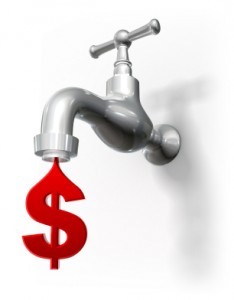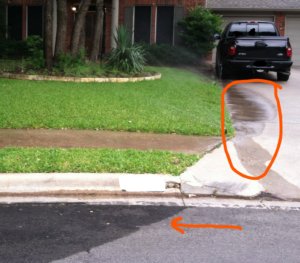The weather has been hit or miss so far this summer, with very little rain since July. The City’s water use, as a whole, has doubled since the beginning of July!! We were using close to 18 million gallons of water per day; now we’re up to 37 million gallons of water per day! That’s a huge increase (city-wide, our use has doubled) all because of the heat. I’m going to go out on a limb and say the high temperatures don’t mean we need to crank up the sprinklers. That would be doing a disservice to our lawns and native plants AND our water source, which is Lake Georgetown.
The City’s water use, as a whole, has doubled since the beginning of July!! We were using close to 18 million gallons of water per day; now we’re up to 37 million gallons of water per day! That’s a huge increase (city-wide, our use has doubled) all because of the heat. I’m going to go out on a limb and say the high temperatures don’t mean we need to crank up the sprinklers. That would be doing a disservice to our lawns and native plants AND our water source, which is Lake Georgetown.
While we aren’t in any mandatory water restrictions right now, the potential is there. The lake levels have dropped from 100% full at the beginning of July, to 86% full as I’m writing this (mid-August). That’s a lot of water reduction in only about 6 weeks!
I’d like to offer you several specific ways to help keep Round Rock’s water use low, so we don’t have to enact mandatory water restrictions. You don’t have to do them all (however saving water = saving money and saving energy), so I just ask that you do as many as you can!
- Fix any and all leaks at your house; this could be
 a leaking toilet, a dripping faucet, or a pipe leak on the mainline. It could be leaks in the irrigation system. Yes, there are a lot of places for water to leak from!
a leaking toilet, a dripping faucet, or a pipe leak on the mainline. It could be leaks in the irrigation system. Yes, there are a lot of places for water to leak from!
- The City’s Utility department has dye tablets and Teflon tape (aka plumber’s tape) for free in the Utility Billing Office. You can also request a free leak kit from the website here or see all our tips for leak detection at your property at roundrocktexas.gov/leaks.
- You can also view your water use on your city water portal; here you can see your weekly, daily, or hourly water use. You would be able to see if you have a leak if there is constant water use all day, even when you are sleeping or gone. This isn’t in real time, there’s about a 12-hour delay, but it’s also great way to see how much you are using for different activities.
- Do not water more than twice per week. This is crucial to keep your lawn and landscape drought tolerant. There are exceptions to this, like brand newly installed plants, gardens, plants in pots, but generally speaking, nothing needs to be watered more than twice per week—some plants even less.
- The problem with watering frequently is that the plant roots don’t grow long and strong. They stay short and close to the plant—knowing they do not need to grow, as water will appear every day, or every other day. Your landscaping goal should be to have a yard that you don’t have to water each summer, right? Get the plant used to occasional watering, by not watering more than twice per week, and even cutting back to once per week.
- Another great way to save is to not water if rain is forecast, or it has just rained—especially if it’s rained more than ½ an inch. Keep the water off for at least a week after a good soak.
- Is your yard thriving this summer? Looking lush and green and not realizing that it’s been over 100 degrees for weeks? Does it look like it needs mowing once per week for sure, if not more? If that’s the case, then I’d say you can reduce your runtimes (minutes) slightly and see if you notice any difference in the yard. If not, great! You’ve just reduced your water consumption. You can try to reduce again, slightly, after a week or two to save some more! By slightly, I’m talking 2 minutes. That’s it—it’s not much, will your lawn even notice? Try it!
- Can you tell when your irrigation system has run because you have water all over your car, or back porch, or running down the street? That’s water is being wasted. That’s water you’ve paid for, but not getting any benefit from.

- Adjusting heads is relatively easy. sometimes over time, the sprinkler heads just move and need some slight adjusting back to spray what they are supposed to spray. In some cases, you can physically turn the head to face the direction it’s supposed to be spraying (this works best when the system is turned on, so you can see if you’re turning it to the right spot).
- Sometimes the head is just spraying water too far—over the landscape and into the street or driveway. We have a nice video that shows how to make that adjustment. It’s also pretty easy, you just need a small, flat-head screwdriver and be willing to get a little wet!
- Consider a smart controller for your irrigation system, rather than a traditional timer.
- A smart controller will adjust for the weather, versus the traditional timer that waters every, just because it’s the set day to water, regardless if it is about to rain, or has just rained. The city’s irrigation rebate program may also cover a portion of the cost of a new controller, if it’s a WaterSense labeled controller.
- Another way to achieve this would be to just water manually, not on a schedule. Actually look at your yard to determine if it looks stressed out (don’t do this during the heat of the day, because of course it will!); look at it first thing in the morning. Is the grass leave blade upright, green, looking strong? Then it’s good, no extra water is needed.
If you are going to water your lawn, we ask that you voluntarily stay on your water days; this way if we do go into mandatory restrictions you won’t need to make any changes.
-
- For odd addresses, that’s Wednesday and/or Saturday.
- For even addresses, that’s Thursday and/or Sunday.
- No automatic irrigation is permitted between 10am – 7pm on any day.
- Watering by hand allowed any day, at any time.
Need more detailed information about the water restrictions? Visit the City website’s Drought Restriction page.


